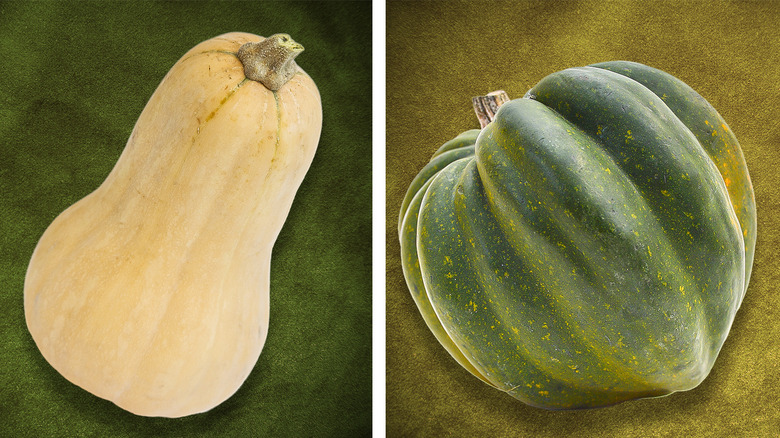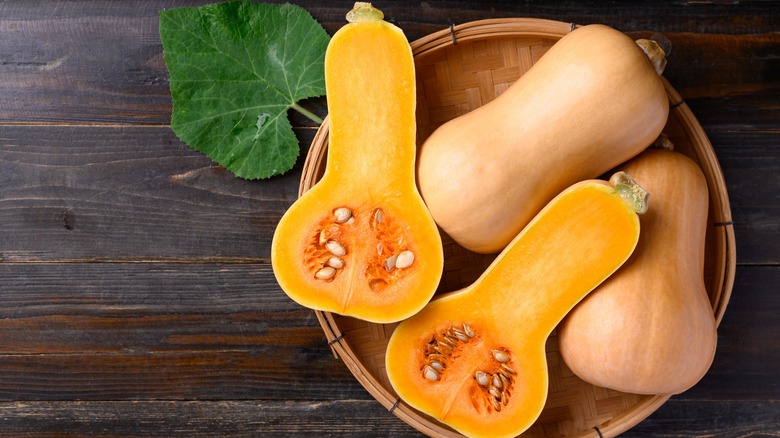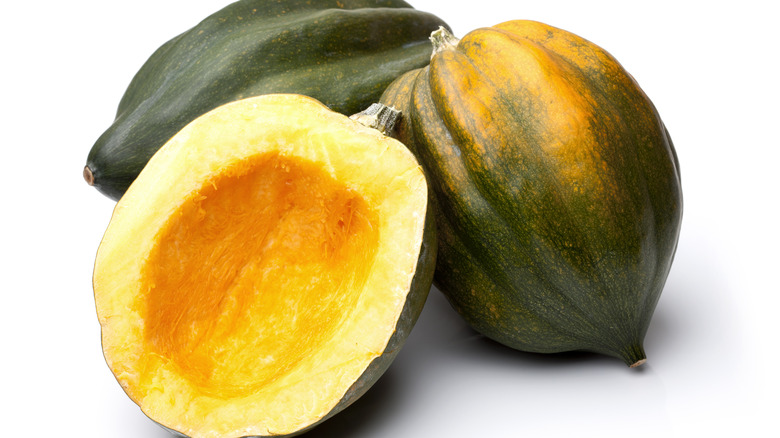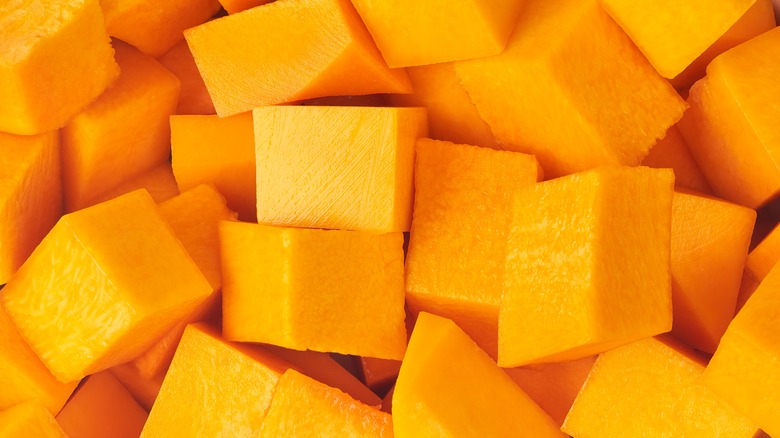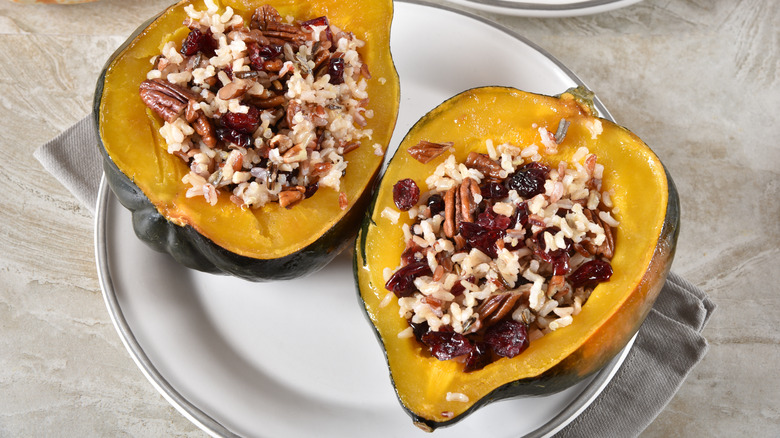Butternut Squash Vs. Acorn: What's The Difference?
Members of the plant family Cucurbitaceae are timeless. While plenty of fruits and vegetables are enjoyed year-round, few have representatives so closely tied to the seasons as the cucurbits, which include melons, gourds, and squash. In the summer, sweet, juicy watermelon and crispy cucumbers refresh and satisfy. In the fall, pumpkins are carved and made into pies. And, in winter, the hearty, nutty, sweet varieties of squash help ward off the cold.
Among these, two of the most common are acorn and butternut squash. These similar cucurbits often get the same treatment; they're roasted to intensify their natural sweetness with maybe a bit of sugar or other sweeteners to up the game and often a luscious lashing of butter and some winter spices to warm things up.
But similar preparations can leave folks wondering just what is different about these two types of squash and when to make use of one over the other. With so many good squash recipes out there, we're taking a deeper dive into the world of acorn and butternut squash to find out what to expect from each type — and, most importantly, how to coax out its most delicious flavor.
What is butternut squash?
With an almost comically elongated, pear-like shape and tan skin, butternut squash, scientifically known as Cucurbita moschata, is a variety renowned for its sweet, nutty flavor and creamy texture. Originating in North America as a horticultural hybrid, this winter squash has become a staple ingredient in many cuisines around the world. Butternut squash typically ranges from 2 to 3 pounds in weight and is full of dense, vibrant orange flesh. And, as a bonus, its seeds are all conveniently located in the bulbous end of the squash.
Butternut squash is incredibly versatile in the kitchen and can be prepared in a variety of ways. It can be roasted, sautéed, steamed, boiled, or even puréed into sauces, desserts, and soups, like this roasted butternut squash soup. Its natural sweetness pairs well with a plethora of herbs and spices like sage, thyme, cinnamon, and nutmeg. Nutritionally, butternut squash is a powerhouse. It is rich in vitamins A and C, as well as potassium, magnesium, and dietary fiber, making it a nutritious addition to any meal.
What is acorn squash?
What do acorn squash look like? You guessed it: acorns. Well, if acorns didn't have caps, were a different color, and had longitudinal ridges, but we're not here to quibble. Scientifically known as Cucurbita pepo var. turbinata, this winter squash has a captivating appearance and a rich, sweet flavor to boot. Acorn squash typically has dark green and orange skin with deep ridges and yellow-orange flesh. Like its butternut cousin, it's native to North America. It's a compact and rotund gourd, usually weighing between 1 and 2 pounds.
For cooks, acorn squash offers a fertile canvas for culinary exploration. It can be baked, steamed, or even microwaved. The sweet, nutty flavor of the flesh pairs beautifully with a wide range of ingredients, including butter, brown sugar, maple syrup, cinnamon, and savory herbs like rosemary and thyme. Acorn squash also has a relatively large interior cavity that is occasionally stuffed with ingredients like wild rice and can even be made into a delicious salad, like this roasted acorn squash wedge salad.
Nutritionally, acorn squash is similar to its butternut cousin, with loads of vitamins A and C, potassium, magnesium, and even more dietary fiber. Its orange flesh also indicates high levels of beta-carotene, an antioxidant known for its immune-boosting properties. Beyond its culinary uses, acorn squash is often incorporated into decorative displays during the autumn months due to its appealing appearance and vibrant colors.
Butternut squash is the meatier choice
The most obvious difference between butternut and acorn squash is the size and shape of each. Butternut squash has an elongated, pear-like shape with a relatively uniform thickness throughout its length. This larger size results in a greater yield of flesh compared to acorn squash. Moreover, butternut squash boasts a smaller seed cavity than other squash and gourds, allowing for more substantial amounts of usable flesh. This makes it an excellent choice for cubing, puréeing, or incorporating into various recipes where a significant amount of squash flesh is desired.
In contrast, acorn squash is smaller and more rounded, with that distinctive shape from which it derives its name. Its smaller size does translate to a smaller yield of flesh, but that isn't a knock against it. Acorn squash features a larger seed cavity in proportion to its overall size. This makes it particularly well-suited for techniques such as stuffing, slicing into rings for roasting, or halving and roasting with fillings. The larger cavity also offers ample space for creative culinary experimentation, allowing for a variety of flavorful stuffing options.
Acorn squash has more delicate skin
The contrast between the skins of butternut squash and acorn squash significantly impacts their culinary preparation and consumption. Butternut squash is characterized by its smoother and relatively easy-to-peel skin compared to the rougher texture of acorn squash skin. However, despite its convenience for peeling and the fact that all winter squash skin is edible, the skin of butternut squash tends to be thicker and less palatable, detracting from the overall eating experience. As a result, it is typically removed before or after cooking, allowing for easier handling and greater enjoyment of the tender flesh within.
Conversely, acorn squash boasts a thinner and more delicate skin, which is almost always left intact during cooking. This not only simplifies preparation but also adds texture and flavor to dishes. When roasted or baked, the skin of acorn squash becomes tender and edible, offering a delightful contrast to the creamy flesh within. Some recipes even capitalize on the edible skin of acorn squash, incorporating it into dishes to enhance both visual appeal and nutritional value.
Butternut squash has smoother, milder flesh
The flesh of butternut squash sets it apart. It has a smoother texture, coupled with a milder flavor profile with starchy, sweet, and nutty notes. These qualities make it an ideal choice for soups, purées, sauces, and desserts. Its creamy consistency blends seamlessly into dishes, imparting a rich, velvety texture when combined with stock, cream, or butter. For an outside-the-box way to use butternut squash, consider adding its sweet, nutty flavor to rich macaroni and cheese by puréeing it into the creamy sauce.
On the other hand, acorn squash boasts a firmer texture and a slightly earthier flavor profile compared to butternut squash. Its flesh is less starchy and has a more pronounced grain, making it better suited for roasting or baking. When cooked, the texture of acorn squash remains intact, providing a satisfying bite and caramelized edges, which enhance its natural sweetness. We're suckers for the orange flesh as a backdrop — and bowl — for a savory blend of sausage, rice, dried fruit, onions, and spices.
